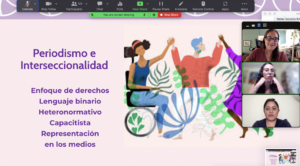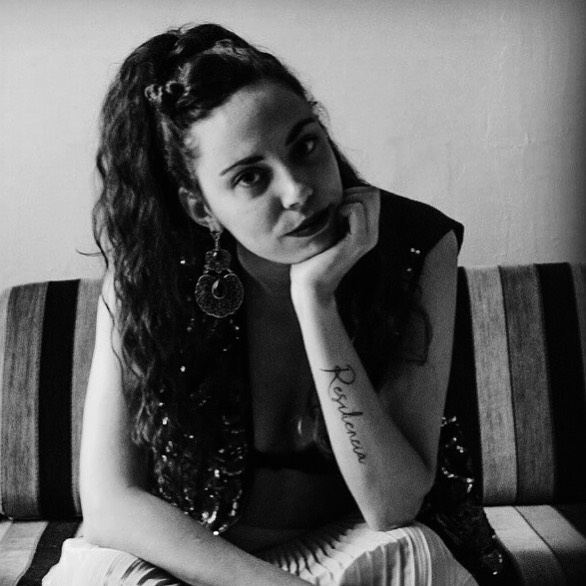Taking risks and putting on "violet glasses" in the newsroom was the main invitation made by panelists of the webinar in Spanish "A gender-based approach and how to achieve intersectional coverage," organized by the Network for Diversity in Latin American Journalism.
The panelists met on March 9, just one day after the demonstrations in commemoration of International Women's Day [IWD] which this year took over most Latin American cities because of the March 8th events. The experts began by briefly explaining the context and history of a gender-based approach, the feminist struggle, intersectionality, and how these concepts can be applied to news coverage, especially on dates such as IWD.

Screenshot webinar "A gender-based approach and how to achieve intersectional coverage"
Mariana Alvarado, from the Network, moderated the conversation with Aminetth Sánchez, general director of the digital native news outlet La Lista, and Alexa Castillo Nájera, journalist, sexologist and feminist activist for the inclusion of diversity.
"These 'violet glasses' are a metaphor to be able to explain how you see life with a gender-based approach. And a gender-based approach is not something you decide. It is something that happens when you turn on the switch of consciousness," Castillo Nájera said. She began by giving a brief tour of the feminist struggle that leads to the commemoration of 8M and why many times receiving congratulations on that day can carry macho components.
Sánchez explained that La Lista made a video designed to be shared especially via Whatsapp and social media such as Facebook, Instagram, and Twitter. The video highlights why this day should not be about congratulations but about explaining the context of this date’s origins.
"I think the work of journalism in that sense is very, very valuable," Sánchez said. "The media have to keep pushing this issue, not to assume that we are all aware that we have been fighting for 100 years and what remains to be done. Rather, we have to see how the information we create meets the needs of those who are just learning about part of the struggle, of those who are already participating and those who have been on this road for many more years."
But in addition to the gender-based approach switch and violet glasses, it is also important to incorporate the concept of intersectionality, which, according to Castillo, means understanding how two or more forms of discrimination interact.
"This tool helps us to see a person in his or her particularity and not make the mistake of generalizing because we miss all the richness of the particularity, of the individuality of each person, his or her personality. We can also observe how these multiple oppressions interact in or affect someone’s life," Castillo said. "The experience of a woman with a mobility disability on the march is not going to be the same as that of a woman standing. It will not be the same for a woman who goes in a group as for one who goes alone [...] So the experience of each person is seen through this instrument."

Aminetth Sánchez.
La Lista has been one of the news outlets that has worked on being able to put this instrument into practice such as the violet glasses. The 8M coverage was no exception. However, Sánchez wanted to explain to her fellow webinar participants two main points: That her work has been a sort of trial and error, and the second, that in her newsroom no one "monopolizes" the gender-based approach and the intersectionality agenda.
"It seems to me that leaving it up to someone to be the policeman in a newsroom can limit the scope a great deal," Sánchez said. "I put these two points on the table first, so that other colleagues who are thinking about implementing it or who are already doing it and are making a lot of mistakes, do not panic. We have to keep walking this path and, surely, if at first we get it wrong, we have to take note of what we got right and learn from what we got wrong."
In the case of events such as 8M, the main thing, according to Sánchez, is to use all the resources available to the newsroom. According to her, one of the media’s main mistakes is to expect a team of two journalists to cover a march in which there are several intersectionalities. La Lista, for example, sent all its journalists, photojournalists, editors, and others to cover the march, distributed by collectives or causes.
"This allowed us to zoom in on each of these causes, because otherwise, I go back to that point, what you are left with is very superficial, with little depth," Sánchez said. She explained how they followed along in this manner Afro women, women with disabilities, women in foster care, women representing persons deprived of liberty, among others. "My recommendation would be this: Let's not try to cover everything with a few hands, because that's not going to work."
This more global perspective was pointed out by Castillo, for whom avoiding "absolutist" visions is a key aspect of a more intersectional and gender-sensitive coverage. For example, under this premise, you could not have an article focused on "the march went like this," so as not to exclude anyone.
The use of language is also part of news coverage with a gender-based approach. Castillo pointed out the importance of moving away from binary structures that leave out people who do not identify with either of them. However, she explained that one of the best ways is to use forms that make sense to the person telling the story.
"If you resist and don't get into the 'todes,' [using the “e” in “todes” is a way to be inclusive in the Spanish language, similar to using an “x” in English, as in “Latinx” instead of “Latino” or “Latina”] don't use it. But don't talk about the history of man, talk about the history of humanity," Castillo said. The key is to try to include all people by using more general words like citizenship or childhood to replace mankind or “niños” [which in Spanish includes both boys and girls].

Alexa Castillo Nájera
Castillo also emphasized that this inclusion through language is not an obligation and imposition, but rather an invitation. An invitation that includes enjoying the richness of the Spanish language.
"It’s important to ask myself what makes sense to me, what fits in my style and what I can incorporate in a natural way to my narrative style that invites and does not exclude," she said.
They also talked about some solutions such as replacing letters with an X or by using symbols such as the “at” sign (@), but that do not always work: Some automatic readers cannot interpret them correctly and people with visual disabilities could not access these texts.
Sánchez offered some techniques La Lista uses that allow for a dialogue between journalism and a gender-based approach. The first one is to look through any story with "a gender magnifying glass." For example, a story about Formula 1 is subject to a gender lens to analyze it from the point of view of women: What are they doing, where are they, whether they benefit or not, among other questions.
A second practice has to do with running all their sources and guests through a search engine to see whether they have received any complaints or had any problems related to the Me Too movement. A third practice is to divide topics according to audiences: For example, within La Lista there is a reporter in charge of the Afro-descendant agenda in Mexico, that she follows up on, and another reporter who follows up on Indigenous community issues, to mention a few.
The session ended with Alvarado's invitation to put on the violet glasses and especially to turn on the switch that can make changes in coverage in a very natural way, with greater inclusion.
The webinar "A gender-based approach and how to achieve intersectional coverage" was the last in a series of four carried out by the Network, with support from the Knight Center for Journalism in the Americas and Google News Initiative. Previous webinars addressed topics such as myths surrounding diversity, how to include LGBTI+ people in newsrooms, and racism and discrimination in migration coverage.